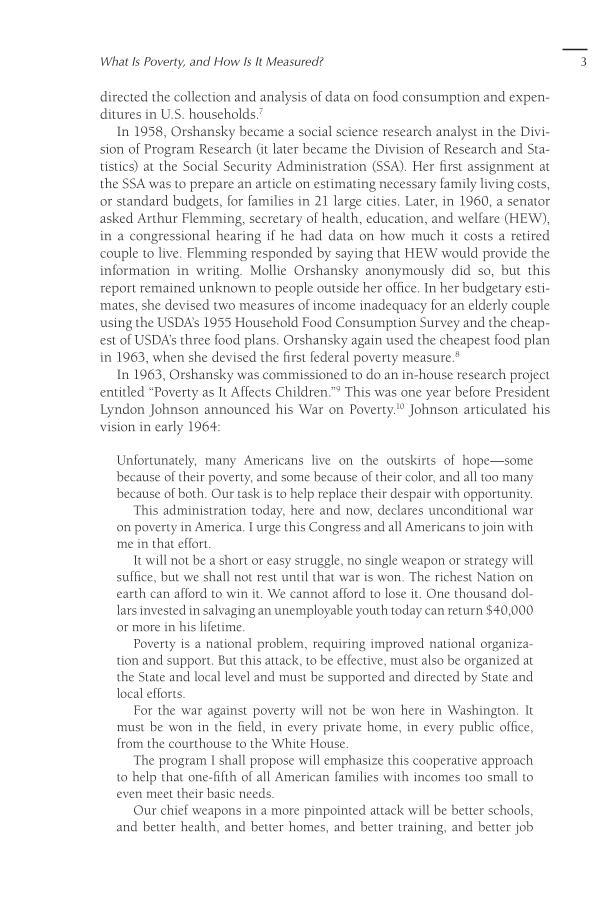What Is Poverty, and How Is It Measured? 3 directed the collection and analysis of data on food consumption and expen ditures in U.S. households.7 In 1958, Orshansky became a social science research analyst in the Divi- sion of Program Research (it later became the Division of Research and Sta- tistics) at the Social Security Administration (SSA). Her first assignment at the SSA was to prepare an article on estimating necessary family living costs, or standard budgets, for families in 21 large cities. Later, in 1960, a senator asked Arthur Flemming, secretary of health, education, and welfare (HEW), in a congressional hearing if he had data on how much it costs a retired couple to live. Flemming responded by saying that HEW would provide the information in writing. Mollie Orshansky anonymously did so, but this report remained unknown to people outside her office. In her budgetary esti- mates, she devised two measures of income inadequacy for an elderly couple using the USDA’s 1955 Household Food Consumption Survey and the cheap- est of USDA’s three food plans. Orshansky again used the cheapest food plan in 1963, when she devised the first federal poverty measure.8 In 1963, Orshansky was commissioned to do an in-house research project entitled “Poverty as It Affects Children.”9 This was one year before President Lyndon Johnson announced his War on Poverty.10 Johnson articulated his vision in early 1964: Unfortunately, many Americans live on the outskirts of hope—some because of their poverty, and some because of their color, and all too many because of both. Our task is to help replace their despair with opportunity. This administration today, here and now, declares unconditional war on poverty in America. I urge this Congress and all Americans to join with me in that effort. It will not be a short or easy struggle, no single weapon or strategy will suffice, but we shall not rest until that war is won. The richest Nation on earth can afford to win it. We cannot afford to lose it. One thousand dol- lars invested in salvaging an unemployable youth today can return $40,000 or more in his lifetime. Poverty is a national problem, requiring improved national organiza- tion and support. But this attack, to be effective, must also be organized at the State and local level and must be supported and directed by State and local efforts. For the war against poverty will not be won here in Washington. It must be won in the field, in every private home, in every public office, from the courthouse to the White House. The program I shall propose will emphasize this cooperative approach to help that one-fifth of all American families with incomes too small to even meet their basic needs. Our chief weapons in a more pinpointed attack will be better schools, and better health, and better homes, and better training, and better job
Document Details My Account Print multiple pages
Print
You have printed 0 times in the last 24 hours.
Your print count will reset on at .
You may print 0 more time(s) before then.
You may print a maximum of 0 pages at a time.
























































































































































































































































